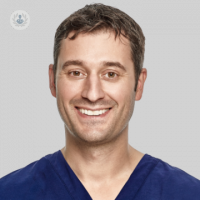Gum graft treatment: what is it and how does it treat receding gums?
Written by:Many people worldwide are affected by receding gums, which occur when the root surfaces of the teeth are exposed due to the gums pulling back from the tooth surface in the mouth.
On hand to provide us with a detailed insight into how receding gums are effectively treated is expert London-based prosthodontics specialist, Professor Christian Mehl. In our latest article, Professor Mehl reveals and describes the main causes of gum recession, whilst also detailing the two main methods adopted in gum grafting treatment.

What are the main causes of receding gums?
There are various causes of gum recession. Minor inflammation of the gums (gingivitis) does not normally cause gum recession, but periodontitis (severe inflammation of the gums and surrounding supporting structures of the teeth) can cause permanent damage to the gums with recession being a common result.
Gum recession not only can cause tooth-related issues such as tooth sensitivity, but can also be aesthetically displeasing. Common complaints from patients with recession are that their tooth roots are exposed, and also that they have black triangles in between the teeth where the inderdental gum has been lost, leaving large gaps.
This in turn leads to other functional problems such as food trapping and makes the teeth harder to keep clean. As gums do not regenerate themselves, surgical correction in the form of gum graft treatment is the only solution to replace the gum tissue that has been lost.
What are the two main methods used in gum grafting?
In order to correct gum recession, there are usually two methods available: the transplantation of tissue or the stretching of tissue. In most cases, both techniques are used in combination. Your dentist will need to conduct a thorough examination and give you in-depth advice on the treatment plan.
In our clinic, the cases are planned virtually using modern technology, which allows the dentists to engage in a much more precise analysis, and offers the opportunity for patients to view the potential result of their treatment in advance.
In the transplantation of tissue procedure, the dentist removes tissue from the patient's palate and introduces it into the gums or between the gums and periosteum (outer layer of the underlying bone). The procedure takes place under local anaesthesia and despite its complexity, the procedure itself only takes between 45 minutes to one hour to complete.
If mucosal tissue and the covering skin has been newly transplanted, an open wound remains at the removal site, which normally heals quickly. The risk of infection is very low.
When only using connective tissue for the transplant, the wound on the palate can be sutured with the residual gingiva (fixed gums). Following the procedure, it might be difficult for the patient to brush their teeth for four to six weeks.
Both of these transplantation methods are highly successful. The transplantation of connective tissue without the covering skin is usually less painful after the operation.
For the stretching of tissue (coronally advanced flap technique) method, the exposed tooth root can be covered without removing a transplant from the palate if there is enough attached gingiva (fixed gums) below the receding gum. The procedure also takes place under local anaesthesia.
In the first step, part of the gum tissue is carefully split from the underlying bone. The tissue can then be gently pulled upwards towards the enamel margin of the tooth and fixed there. Special cuts take the tension off the gum flap. The newly positioned gums are fixed with sutures and can then gradually heal.
This procedure can also be used in the lateral direction. The dentist does not push the loosened gums in the direction of the tooth, but laterally in the direction of the neighbouring tooth root. Compared to the transplantation of tissue, this technique only creates one surgical area, but is also limited to minor gum defects.
Preparation for gum graft treatment
To ensure a successful result of a periodontal surgery, teeth and gums must both be in a healthy condition. Bone loss, which is often associated with advanced periodontal disease, should not be too severe.
Gum disease, such as gingivitis or periodontitis, should be treated in advance. Your dentist may also recommend a nightguard to prevent damage from teeth grinding (bruxism). For diabetic patients, the blood sugar level should be adjusted before the gum graft surgery takes place.
Generally, thin gums can often be compensated for with a tissue transplant from the palate. However, if the gum recession has already extensively progressed, surgery can only help to achieve an improvement, not the original form of the gum anatomy.
If you are considering undergoing gum graft treatment and wish to consult with a trusted, experienced dental and prosthodontics specialist, Professor Christian Mehl is your go-to. Visit his Top Doctors profile today to schedule an appointment with him.


